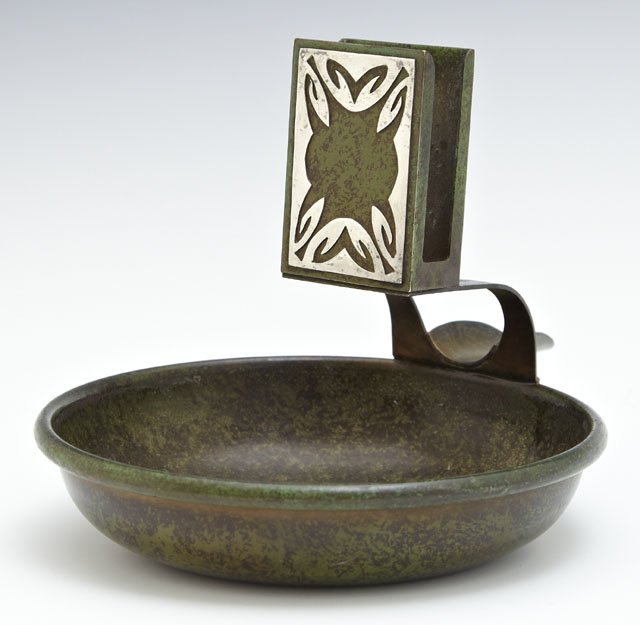Notes: Marked #2654, Sterling design on matchbox holder
Dimensions: 5" High x 5 1/2" Wide x 6 1/2" Deep
Manufacturer History: Heintz family history dates back to 1875 as an established jewelry manufacturer in New York. With this background, Otto Heintz purchased a small company in 1902 which he renamed the Heintz Art Metal Shop and began copper metalwork. He soon changed his work in copper to producing bronze pieces with a sterling silver overlay without using solder. Proud of this craftsmanship, Heintz received a patent for this silver-on-bronze work without solder on August 27, 1912. This date, PAT.AUG.27.12, will appear on signed Heintz pieces under the company's logo, the initials "HAMS" enclosed by a diamond.
Heintz produced a variety of pieces including vases, bowls, jewelry, smoking accessories, bookends, ect. Heintz manufactured these items with a diverse selection of patinas, the finish applied to metalwork, by including various tones and hues from green (Verde Patina) and red (Royal Patina) to the most common brown patina associated with the Arts and Crafts movement. The Heintz Shop also produced items with plated finishes in silver (French Grey Silver or Acid Etched) and gold (Gold Dore).
After Otto Heintz died in 1918, the Heintz Art Metal Shop's sales manager Fred Smith opened his own shop, Smith Metal Arts Company (Silver Crest), to compete against his former employer. The influence of Heintz metalwork is apparent among many Silver Crest vases and bowls. Along with deserting Heintz craftsmen, Silver Crest began to produce silver-on-bronze pieces with a striking resemblance to Heintz metalwork, if not for the Silver Crest trademark. The Heintz Art Metal Shop operated until 1930, 12 years after the establishment of the competing company.
Heintz produced a variety of pieces including vases, bowls, jewelry, smoking accessories, bookends, ect. Heintz manufactured these items with a diverse selection of patinas, the finish applied to metalwork, by including various tones and hues from green (Verde Patina) and red (Royal Patina) to the most common brown patina associated with the Arts and Crafts movement. The Heintz Shop also produced items with plated finishes in silver (French Grey Silver or Acid Etched) and gold (Gold Dore).
After Otto Heintz died in 1918, the Heintz Art Metal Shop's sales manager Fred Smith opened his own shop, Smith Metal Arts Company (Silver Crest), to compete against his former employer. The influence of Heintz metalwork is apparent among many Silver Crest vases and bowls. Along with deserting Heintz craftsmen, Silver Crest began to produce silver-on-bronze pieces with a striking resemblance to Heintz metalwork, if not for the Silver Crest trademark. The Heintz Art Metal Shop operated until 1930, 12 years after the establishment of the competing company.
Item created by: nmwhite997 on 2016-07-12 11:47:03. Last edited by nmwhite997 on 2016-07-12 14:47:03
If you see errors or missing data in this entry, please feel free to log in and edit it. Anyone with a Gmail account can log in instantly.
If you see errors or missing data in this entry, please feel free to log in and edit it. Anyone with a Gmail account can log in instantly.







